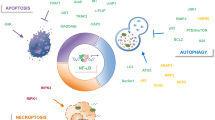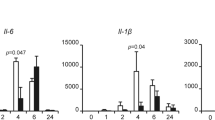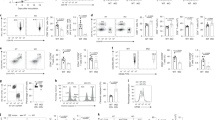Abstract
Cell proliferation is a metabolically demanding process1,2. It requires active reprogramming of cellular bioenergetic pathways towards glucose metabolism to support anabolic growth1,2. NF-κB/Rel transcription factors coordinate many of the signals that drive proliferation during immunity, inflammation and oncogenesis3, but whether NF-κB regulates the metabolic reprogramming required for cell division during these processes is unknown. Here, we report that NF-κB organizes energy metabolism networks by controlling the balance between the utilization of glycolysis and mitochondrial respiration. NF-κB inhibition causes cellular reprogramming to aerobic glycolysis under basal conditions and induces necrosis on glucose starvation. The metabolic reorganization that results from NF-κB inhibition overcomes the requirement for tumour suppressor mutation in oncogenic transformation and impairs metabolic adaptation in cancer in vivo. This NF-κB-dependent metabolic pathway involves stimulation of oxidative phosphorylation through upregulation of mitochondrial synthesis of cytochrome c oxidase 2 (SCO2; ref. 4). Our findings identify NF-κB as a physiological regulator of mitochondrial respiration and establish a role for NF-κB in metabolic adaptation in normal cells and cancer.
This is a preview of subscription content, access via your institution
Access options
Subscribe to this journal
Receive 12 print issues and online access
$209.00 per year
only $17.42 per issue
Buy this article
- Purchase on Springer Link
- Instant access to full article PDF
Prices may be subject to local taxes which are calculated during checkout





Similar content being viewed by others
References
Jones, R. G. & Thompson, C. B. Tumor suppressors and cell metabolism: a recipe for cancer growth. Genes Dev. 23, 537–548 (2009).
Vander Heiden, M. G., Cantley, L. C. & Thompson, C. B. Understanding the Warburg effect: the metabolic requirements of cell proliferation. Science 324, 1029–1033 (2009).
Karin, M. Nuclear factor-κB in cancer development and progression. Nature 441, 431–436 (2006).
Leary, S. C. Redox regulation of SCO protein function: controlling copper at a mitochondrial crossroad. Antioxid. Redox Signal. 13, 1403–1416 (2010).
Vousden, K. H. & Ryan, K. M. p53 and metabolism. Nat. Rev. Cancer 9, 691–700 (2009).
Jones, R. G. et al. AMP-activated protein kinase induces a p53-dependent metabolic checkpoint. Mol. Cell 18, 283–293 (2005).
Matoba, S. et al. p53 regulates mitochondrial respiration. Science 312, 1650–1653 (2006).
Cuezva, J. M. et al. The tumor suppressor function of mitochondria: translation into the clinics. Biochim. Biophys. Acta 1792, 1145–1158 (2009).
Wu, M. et al. Multiparameter metabolic analysis reveals a close linkbetween attenuated mitochondrial bioenergetic function and enhanced glycolysis dependency in human tumor cells. Am. J. Physiol. Cell Physiol. 292, 125–136 (2007).
Maiuri, M. C., Zalckvar, E., Kimchi, A. & Kroemer, G. Self-eating and self-killing: crosstalk between autophagy and apoptosis. Nat. Rev. Mol. Cell Biol. 8, 741–752 (2007).
Vousden, K. H. & Prives, C. Blinded by the light: the growing complexity of p53. Cell 137, 413–431 (2009).
Kirch, H. C. et al. Expression of human p53 requires synergistic activation of transcription from the p53 promoter by AP-1, NF-κB and Myc/Max. Oncogene 18, 2728–2738 (1999).
Ide, T. et al. GAMT, a p53-inducible modulator of apoptosis, is critical for the adaptive response to nutrient stress. Mol. Cell 36, 379–392 (2009).
Kawauchi, K., Araki, K., Tobiume, K. & Tanaka, N. p53 regulates glucose metabolism through an IKK-NF-κB pathway and inhibits cell transformation. Nat. Cell Biol. 10, 611–618 (2008).
Meylan, E. et al. Requirement for NF-κB signalling in a mouse model of lung adenocarcinoma. Nature 462, 104–107 (2009).
Schwartzenberg-Bar-Yoseph, F., Armoni, M. & Karnieli, E. The tumor suppressor p53 down-regulates glucose transporters GLUT1 and GLUT4 gene expression. Cancer Res. 64, 2627–2633 (2004).
Kondoh, H. et al. Glycolytic enzymes can modulate cellular life span. Cancer Res. 65, 177–185 (2005).
Bensaad, K. et al. TIGAR, a p53-inducible regulator of glycolysis and apoptosis. Cell 126, 107–120 (2006).
Vousden, K. H. Alternative fuel—another role for p53 in the regulation of metabolism. Proc. Natl Acad. Sci. USA 107, 7117–7118 (2010).
Locasale, J. W., Cantley, L. C. & Vander Heiden, M. G. Cancer’s insatiable appetite. Nat. Biotechnol. 10, 916–917 (2009).
Hanson, J. L., Hawke, N. A., Kashatus, D. & Baldwin, A. S. The nuclear factor-κB subunits RelA/p65 and c-Rel potentiate but are not required for Ras-induced cellular transformation. Cancer Res. 64, 7248–7255 (2004).
Luo, J. L. et al. Inhibition of NF-κB in cancer cells converts inflammation-induced tumour growth mediated by TNFα to TRAIL-mediated tumour regression. Cancer Cell. 6, 297–305 (2004).
Greten, F. R. et al. IKKβ links inflammation and tumourigenesis in a mouse model of colitis-associated cancer. Cell 118, 285–296 (2004).
Buzzai, M. et al. Systemic treatment with the antidiabetic drug metformin selectively impairs p53-deficient tumor cell growth. Cancer Res. 67, 6745–6752 (2007).
Tergaonkar, V. & Perkins, N. D. p53 and NF-κB crosstalk: IKKα tips the balance. Mol. Cell 26, 158–159 (2007).
Sablina, A. A. et al. The antioxidant function of the p53 tumor suppressor. Nat. Med. 11, 1306–1313 (2005).
Wang, J. et al. RelA/p65 functions to maintain cellular senescence by regulating genomic stability and DNA repair. EMBO Rep. 10, 1272–1278 (2009).
Dajee, M. et al. NF-κB blockade and oncogenic Ras trigger invasive human epidermal neoplasia. Nature 421, 639–643 (2003).
Gapuzan, M-E. R. et al. Immortalized fibroblasts from NF-κB RelA knockout mice show phenotypic heterogeneity and maintain increased sensitivity to tumor necrosis factor α after transformation by v-Ras. Oncogene 24, 6574–6583 (2005).
He, G. et al. Hepatocyte IKKβ/NF-κB inhibits tumor promotion and progression by preventing oxidative stress-driven STAT3 activation. Cancer Cell. 17, 286–297 (2010).
Bassères, D. S., Ebbs, A., Levantini, E. & Baldwin, A. S. Requirement of the NF-κB subunit p65/RelA for K-Ras-induced lung tumorigenesis. Cancer Res. 71, 3537–3546 (2010).
Weinberg, F. et al. Mitochondrial metabolism and ROS generation are essential for Kras-mediated tumourigenicity. Proc. Natl Acad. Sci. USA 107, 8788–8793 (2010).
Guo, J. Y. et al. Activated Ras requires autophagy to maintain oxidative metabolism and tumourigenesis. Genes Dev. 25, 460–470 (2011).
Pham, C. G. et al. Ferritin heavy chain upregulation by NF-κB inhibits TNFα-induced apoptosis by suppressing reactive oxygen species. Cell 119, 529–542 (2004).
Yang, H. et al. TNF- αinhibits asbestos-induced cytotoxicity via a NF-κB-dependent pathway, a possible mechanism for asbestos-induced oncogenesis. Proc. Natl Acad. Sci. USA 103, 10397–10402 (2006).
Dull, T. et al. A third-generation lentivirus vector with a conditional packaging system. J. Virol. 72, 8463–8471 (1998).
Zong, W. X. et al. Alkylating DNA damage stimulates a regulated form of necrotic cell death. Genes Dev. 18, 1272–1282 (2004).
Crighton, D. et al. DRAM, a p53-induced modulator of autophagy, is critical for apoptosis. Cell 126, 121–134 (2006).
Zinszner, H. et al. CHOP is implicated in programmed cell death in response to impaired function of the endoplasmic reticulum. Genes Dev. 12, 982–995 (1998).
Fullwood, M. J. et al. An oestrogen-receptor- α-bound human chromatin interactome. Nature 462, 58–64 (2009).
Acknowledgements
We thank M. Pagano, F. Dazzi, P. Ashton-Rickardt, F. Marelli-Berg and G. Screaton for critical comments on the manuscript. We also thank K. Ryan (Beatson Institute for Cancer Research, Glasgow, UK) for the eGFP–LC3 plasmid; T. Lindsten and C. B. Thompson (University of Pennsylvania, Philadelphia, USA) for the immortalized Bax−/−/Bak−/− MEFs; D. Trono (Ecole Polytechnique Fédérale de Lausanne, Lausanne, Switzerland) for the pWPT lentiviral vector; C. Chevtzoff and D. G. Hardie for assistance with the use of the Seahorse machine; and K. R. Chng for assistance with the analyses of the p53 promoter. C.M. was supported in part by a fellowship from AIRC (Italy). S.C.L. is supported by a scholarship from A*STAR (Singapore). M.M. is supported by a fellowship from the Pasteur Institute, Cenci Bolognetti Foundation (Italy). This work was supported by NIH grants R01 CA084040 and R01 CA098583 and Cancer Research UK grant C26587/A8839 to G.F., and NIH grant R01 CA123067 to N.S.C.
Author information
Authors and Affiliations
Contributions
C.M. first observed the glucose addiction exhibited by RelA-null cells. C.M. and S.C.L. carried out the further experimental characterization of this phenomenon and most of the analyses shown. E.A. and S.R. carried out the oxygen consumption assays. A.K.T. carried out the cell-cycle analysis and helped with in vivo studies. L.T. carried out the immunoblot analyses of apoptosis and autophagy and the in vitro metabolic analyses of CT-26 cells. E.D.S. and A.A.B. generated the early passage p 53−/− and RelA−/− MEFs, respectively, as well as the early passage wild-type controls from littermates. G.F., C.M. and S.C.L. wrote the manuscript and conceived the experiments. N.S.C. and V.T. contributed to the design of some of the experiments and made substantial critical revision to the manuscript. C.M., E.A., A.K.T., L.T. and M.M. carried out the experiments during revision of the manuscript. All authors discussed and revised the manuscript.
Corresponding author
Ethics declarations
Competing interests
The authors declare no competing financial interests.
Supplementary information
Supplementary Information
Supplementary Information (PDF 1815 kb)
Supplementary Table 1
Supplementary Information (XLS 22 kb)
Supplementary Table 2
Supplementary Information (XLSX 12 kb)
Rights and permissions
About this article
Cite this article
Mauro, C., Leow, S., Anso, E. et al. NF-κB controls energy homeostasis and metabolic adaptation by upregulating mitochondrial respiration. Nat Cell Biol 13, 1272–1279 (2011). https://doi.org/10.1038/ncb2324
Received:
Accepted:
Published:
Issue Date:
DOI: https://doi.org/10.1038/ncb2324
This article is cited by
-
Disclosing a metabolic signature of cisplatin resistance in MDA-MB-231 triple-negative breast cancer cells by NMR metabolomics
Cancer Cell International (2023)
-
PMCA inhibition reverses drug resistance in clinically refractory cancer patient-derived models
BMC Medicine (2023)
-
Flavinated SDHA underlies the change in intrinsic optical properties of oral cancers
Communications Biology (2023)
-
Genetic deletion and pharmacologic inhibition of E3 ubiquitin ligase HOIP impairs the propagation of myeloid leukemia
Leukemia (2023)
-
The role of LOXL2 induced by glucose metabolism-activated NF-κB in maintaining drug resistance through EMT and cancer stemness in gemcitabine-resistant PDAC
Journal of Molecular Medicine (2023)



